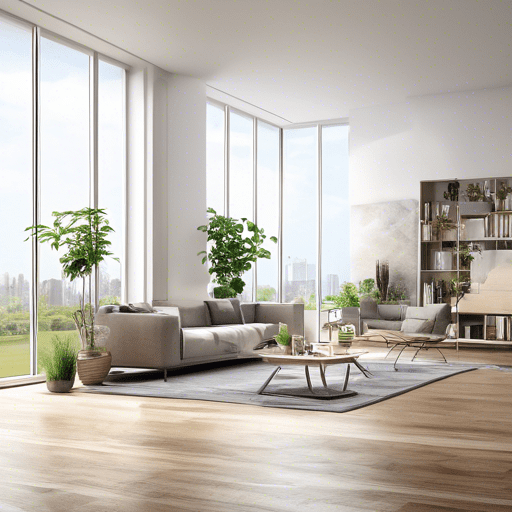Introduction Stormwater runoff refers to the water from snowmelt or rainfall that flows over land. Generally, it includes runoff from

Research shows that air quality problems in commercial and residential buildings are usually associated with inadequacies in building design and operation methods. Moreover, the systems designed to control indoor air quality can become indirect sources of contaminants if they’re not properly maintained at each stage of the building’s life.
Therefore, facility managers, building owners, and HVAC engineers across the country need to set goals that will improve indoor air quality in these facilities. This will play a crucial role in attracting tenants back into commercial workspaces and improving the employees’ productivity. More importantly, indoor air quality focuses on airborne contaminants as well as the comfort, safety, and health issues of the occupants.
According to various studies, most people in the United States spend more than 90% of their time indoors, which is not surprising seeing that we’ve advanced from an outdoor hunter-gatherer existence as a species. Unfortunately, statistics released by the United States Environmental Protection Agency (EPA) show that indoor environments can sometimes have higher levels of contaminants than those found outdoors. Poor indoor air quality in commercial buildings has been linked to various problems like chronic health issues such as asthma, low employee productivity, higher operational costs, and increased cases of absenteeism.
To overcome these issues, it’s about time that building owners and operators prioritize cleaning up the air that occupants breathe and ensure air quality improvement. In addition, HVAC systems in various buildings should be designed to provide acceptable air quality and thermal conditions within occupied spaces.
In this section, we’ll give you a practical guide to improving IAQ and meeting climate resiliency, and building decarbonization goals. This four-step framework shows that it’s possible to achieve better/ sustainable indoor quality with improved resilience to outdoor airborne contaminants more energy efficiently.
The first step to improving indoor air quality in any building is to identify the most important air factors in the indoor space. Start with leading indicators that represent the big classes of problems and proceed from there.
However, you should not rely on carbon dioxide as the main indicator of good indoor air quality. Instead, you should define indoor air quality goals for ozone, formaldehyde, carbon monoxide, and particulate matter that exceed or meet the acceptable indoor air quality design limits recommended by ASHRAE Standard 62.1-2019. In addition, you should set a target of 6 eACH (equivalent Air Changes per Hour) to minimize the risk of airborne virus transmissions.
The next step is to maximize the amount of cost-effective clean air in indoor spaces for recirculated air. You should evaluate cost-effectiveness depending on the total lifecycle costs needed to achieve your air quality targets. In most climates, cleaning indoor air is more cost-effective and energy-efficient than conditioning large volumes of outdoor air.
For pathogens and particle filtration, incorporate MERV 13 filters in HVAC design systems. And for gaseous contaminants, you can use sorbent filters that handle various contaminants highlighted by ASHRAE Standard 62.1. In addition, you should add in-room germicidal UV light or HEPA filters during pandemics to reduce risk in indoor spaces where the main HVAC systems cannot deliver 6 equivalent Air Changes per Hour and in high-risk areas.
After maximizing the amount of cost-effective clean air for recirculated air, determine how much outdoor air is needed in addition to the clean indoor air to achieve your IAQ targets and comply with the building codes. Next, optimize ventilation by deploying energy-recovery HVAC systems while high latent & sensible load recovery to increase the efficiency of conditioning the outdoor air. Even better, adding high-efficiency energy recovery systems for optimized ventilation will reduce operating costs and improve energy efficiency further.
Alternatively, combine layered air cleaning systems with optimized ventilation rates according to the ASHRAE’s IAQ procedure to meet the Indoor Air Quality goals more cost-effectively and energy efficiently. In addition, combine the cleaned indoor air with optimized ventilation rates to allow all-electric designs using heat pumps and smaller energy recovery systems that offer better performance in colder climates.
Lastly, continuously monitor the air quality using validated 3rd party sensors to track the levels of particulate matter, COs, ozone, and TVOCs in indoor spaces. Also, make sure you conduct point-in-time testing for carbon monoxide and formaldehyde at least twice a year.
On the same note, you can use aerosol tracers to determine the combined effects of filtration and ventilation systems for airborne pathogens. More importantly, integrate the data of the Indoor Air Quality sensor with building management systems and automate the optimization for ventilation and air cleaning to ensure increased occupant comfort, efficiency, IAQ, and resiliency!
Conclusion
To create high Indoor Air Quality, low-energy, climate-resilient buildings, we needed to adopt alternatives to outdoor air ventilation to maintain healthy environments in indoor spaces. At Innodez, our HVAC engineers design and implement quality improvement solutions to ensure commercial and residential buildings in California have good IAQ. To learn more, contact us today to discuss how we can help you start monitoring and improving the air quality of your facility!
Air Quality Improvement
About Author
InnoDez